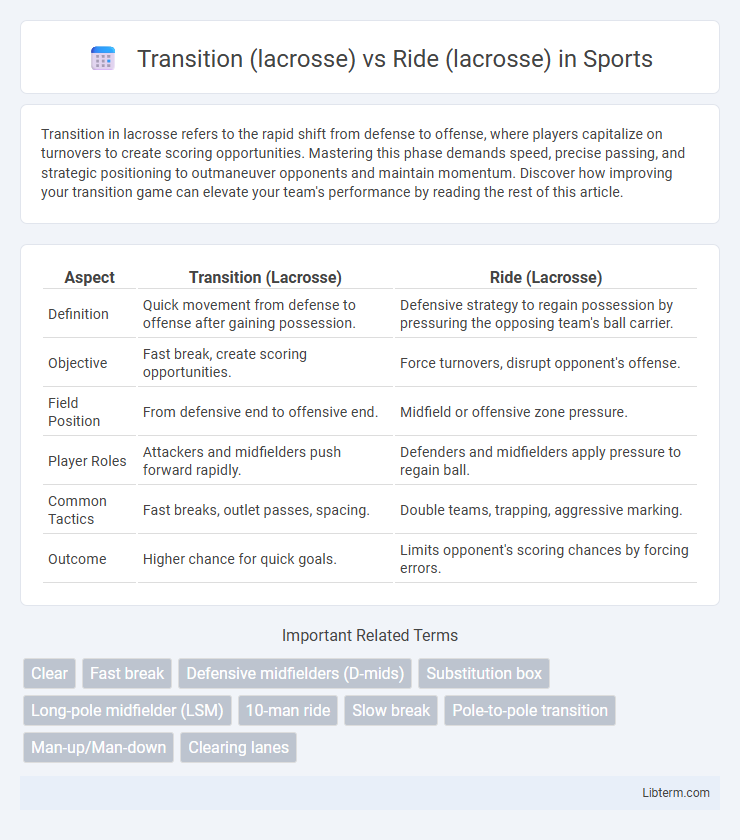Transition in lacrosse refers to the rapid shift from defense to offense, where players capitalize on turnovers to create scoring opportunities. Mastering this phase demands speed, precise passing, and strategic positioning to outmaneuver opponents and maintain momentum. Discover how improving your transition game can elevate your team's performance by reading the rest of this article.
Table of Comparison
| Aspect | Transition (Lacrosse) | Ride (Lacrosse) |
|---|---|---|
| Definition | Quick movement from defense to offense after gaining possession. | Defensive strategy to regain possession by pressuring the opposing team's ball carrier. |
| Objective | Fast break, create scoring opportunities. | Force turnovers, disrupt opponent's offense. |
| Field Position | From defensive end to offensive end. | Midfield or offensive zone pressure. |
| Player Roles | Attackers and midfielders push forward rapidly. | Defenders and midfielders apply pressure to regain ball. |
| Common Tactics | Fast breaks, outlet passes, spacing. | Double teams, trapping, aggressive marking. |
| Outcome | Higher chance for quick goals. | Limits opponent's scoring chances by forcing errors. |
Understanding Transition in Lacrosse
Transition in lacrosse refers to the strategic phase where a team rapidly shifts from defense to offense after gaining possession of the ball, aiming to exploit unsettled defenses and create high-percentage scoring opportunities. This contrasts with a ride, which is the defensive effort focused on regaining possession by pressuring the opposing team's transition. Effective transition gameplay requires precise passing, quick decision-making, and coordinated movement to outpace opponents and maintain offensive momentum.
Defining the Ride in Lacrosse
The ride in lacrosse is a defensive strategy focused on regaining possession immediately after losing the ball, typically applied to disrupt an opponent's clear and force turnovers in the offensive zone. Unlike transition, which emphasizes quick movement from defense to offense to capitalize on fast breaks, the ride prioritizes structured pressure and coordination among defenders to contain ball carriers and force mistakes. Effective rides leverage aggressive tactics such as double-teaming and strategic positioning to maintain territorial advantage and reduce scoring opportunities for the opposition.
Key Differences: Transition vs Ride
Transition in lacrosse emphasizes quickly shifting from defense to offense to create fast-break opportunities and capitalize on unsettled situations, requiring speed and coordination across the entire team. Ride focuses on defensive pressure applied by the team without the ball, aiming to force turnovers and slow down the opponent's clearing process through aggressive stick checks and positioning. The key difference lies in transition being an offensive strategy after gaining possession, while ride is a defensive tactic intended to regain possession before the opponent can initiate their offense.
Objectives of Transition Play
Transition in lacrosse focuses on quickly moving the ball from defense to offense to create scoring opportunities before the opposing defense sets up, emphasizing speed, spacing, and effective passing. Ride in lacrosse aims to pressure the opposing team during their clearing attempt to force turnovers, delay their transition, and regain possession. The primary objective of transition play is to exploit unsettled defenses for high-percentage scoring chances, while ride play seeks to disrupt the opponent's advance and maintain defensive control.
Purpose of the Ride Strategy
The Ride strategy in lacrosse focuses on applying intense defensive pressure to force turnovers and prevent the opposing team's transition from defense to offense. By disrupting clears and intercepting passes, the ride aims to regain possession quickly and initiate scoring opportunities. This approach contrasts with general transition play, which prioritizes fast breaks and offensive movement after gaining control of the ball.
Common Transition Tactics
Transition in lacrosse involves quickly moving the ball from defense to offense to capitalize on scoring opportunities, while ride focuses on applying pressure to force turnovers during the opponent's transition. Common transition tactics include fast breaks, outlet passes from the goalie, and maintaining spacing to exploit defensive gaps. Effective ride strategies revolve around coordinated communication, aggressive positioning, and strategic double-teaming to disrupt the opposing team's clear.
Effective Ride Techniques
Effective ride techniques in lacrosse emphasize strategic positioning and active stick checking to disrupt the opposing team's transition from defense to offense. Players maximize ball pressure and anticipate passing lanes to force turnovers and slow the ball carrier's progress during transitions. Employing coordinated team rides, including trap formations and layered defensive sets, enhances the chances of regaining possession and initiating fast breaks.
Impact on Game Flow and Momentum
Transition in lacrosse involves quickly shifting from defense to offense, creating fast-break opportunities that can catch opponents off guard and significantly accelerate game flow. Ride, on the other hand, is a defensive strategy aimed at disrupting the opposing team's clear and preventing them from advancing the ball, which slows their transition and can shift momentum by forcing turnovers or shot clock violations. Both transition and ride directly impact momentum, with transition boosting scoring chances during rapid offensive surges and ride controlling the pace by applying pressure to limit opponent progression.
Skills Required for Transition vs Ride
Transition in lacrosse demands exceptional speed, agility, and endurance to quickly shift from defense to offense, emphasizing precise passing, ball control, and spatial awareness. Ride requires intense defensive skills such as positioning, stick checking, communication, and the ability to anticipate opponent movements to apply pressure and force turnovers. Both roles necessitate high-level situational awareness but focus on different skill sets: transition prioritizes offensive initiation, while ride centers on defensive disruption.
Transition and Ride: Training and Drills
Effective lacrosse transition and ride training emphasizes speed, communication, and situational awareness to quickly shift from defense to offense and vice versa. Key drills include full-field sprints for transition conditioning and coordinated team pressure exercises to enhance ride effectiveness, forcing turnovers and regaining ball control. Focused practice on transition clears and ride slides improves player adaptability and execution during high-intensity game moments.
Transition (lacrosse) Infographic

 libterm.com
libterm.com